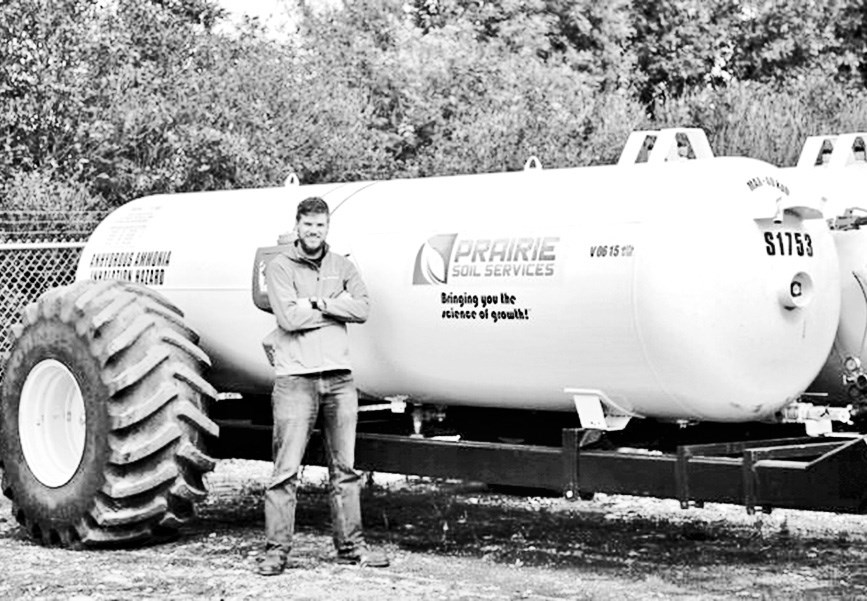By Dan Owen, Agronomy manager
Prairie Soil Services Ltd.
The practice of applying the nitrogen requirements for next year’s crop in the proceeding fall is not a new thing on the prairies, with thousands of acres receiving either anhydrous ammonia (NH3) or banded urea. With that season shortly upon us we should remind ourselves of some of the benefits and pitfalls of this practice and dispel some of the myths surrounding the operation.
While many inorganic nitrogen sources are available in the marketplace, for fall application the only recommended sources are anhydrous ammonia (NH3) and ammonium sulfate. Ammonia transforms quickly to ammonium (NH4+), and nitrogen in ammonium sulfate is already in the ammonium form. Ammonium is absorbed onto the exchange sites in soil particles and organic matter, and thus it is protected from leaching.
Another common nitrogen source is urea. Urea converts to ammonia and then to ammonium within a few days of application. However, research results indicate that this fertilizer should not be used in the fall because it has a greater risk of loss compared with anhydrous ammonia before rapid nutrient uptake by the crop the following spring. The same can be said of polymer-coated ureas. While the coating protects urea for a while, often urea starts to diffuse out of the granule too early, and the loss potential is higher than for anhydrous ammonia. One of the benefits of anhydrous ammonia is that it kills nitrifying bacteria (which are responsible for the transformation of ammonium to nitrate) at the point of application. In addition, as ammonia reacts with water to form ammonium, the reaction creates an alkaline (high pH) environment in the ammonia retention zone. This high pH also inhibits activity of nitrifying bacteria for a while, but the effects are temporary.
So now we know the products to use, let’s have a look at dispelling some of the myths surrounding fall fertilization:
Is it true that anhydrous ammonia makes soil hard?
There are some situations where anhydrous ammonia could reduce permeability, but these situations are the exception rather than the norm. Anhydrous ammonia, at the point of injection, can dissolve a portion of soil organic matter, allowing it to move with soil water. On low organic matter soils, where any loss or alteration in organic matter is detrimental, this effect can make the soil seem hard and impermeable. On other soils, this organic matter dissolution and movement actually improves soil structure.
Doesn’t anhydrous ammonia damage the soil more than urea (4600)?
Although urea and anhydrous ammonia are physically different prior to application, in soil, urea is rapidly converted into ammonia and has properties identical to anhydrous ammonia. Any of the beneficial or detrimental aspects of anhydrous ammonia on soil are equally applicable to urea since they form the same chemicals in the soil.
What effect does anhydrous ammonia (or urea) have on soil micro-organisms?
Immediately after fertilization, high concentrations of ammonia temporarily inhibit soil microbes in the fertilizer retention zone. Bacteria are sensitive to ammonia and are affected by this to a greater extent than fungi. Over time, ammonia concentrations gradually decline as the ammonia adheres to soil particles or moves with water away from the application site. As ammonia concentrations decrease, soil microbes repopulate the affected area.
Isn’t it bad to kill soil microbes?
Whether they realize it or not, many farmers take advantage of this aspect of anhydrous ammonia to maximize nitrogen fertilizer efficiency. When nitrogen is applied in the fall, one of the goals is to minimize the amount of fertilizer that goes into the winter in the nitrate form since nitrate can move with water out of the root zone or can be lost back to the atmosphere as nitrogen gas and other greenhouse gases in the spring. When urea or anhydrous ammonia are banded, the concentrated ammonia temporarily hinders bacteria that normally convert ammonia to nitrate, and the fertilizer remains in a form that cannot be lost from the soil.
So with the myths busted we can now concentrate on the benefits of fall applied fertiliser, these benefits are:
Fall fertilization shifts some of the growing season workload from the spring to the fall. The efficiency of seeding operations can improve dramatically if the majority of N fertilizer is fall applied, and fertilizer handling is minimized at seeding.
Fertilizer prices tend to be lower in the fall than in the spring, often leading to an economic advantage with fall fertilization over spring fertilization.
Soils also tend to be drier in the fall than in the spring, leading to fewer soil compaction problems in the subsequent crop.
With the banding process stubbles are incorporated leaving the soil darker which will help to get the soil warmer in the spring which could facilitate earlier planting.




